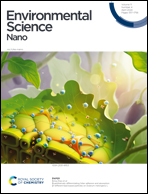Ecotoxicity testing of nanomaterials in sediment – suggestions to improve science and regulation†
Abstract
Sediments generally act as a sink of released manufactured nanomaterials (NMs). As of January 2020, the Annexes of the European Union's chemical legislation (REACH) were revised and now clarify the information requirements that apply to manufacturers, importers, and downstream users when it comes to NMs. However, the guidance provided by the European Chemicals Agency (ECHA) on how to meet the information requirements and chemical safety assessment for NMs is still sparse regarding the sediment compartment. This has raised concern whether methods and guidance currently present are adequate for assessing the information requirement and ultimately the safety assessment of the NMs. The aim of this study is twofold. First, assess how the scientific literature on sediment ecotoxicity of metal nanoparticles (NPs) addresses the regulatory provisions on sediment toxicological testing of NMs. Second, provide suggestions for further revisions of ECHA guidance and ecotoxicological testing of metal NPs in sediments. Our analysis revealed that about 70% of the scientific studies analyzed applied the methods recommended by ECHA for spiking NPs into sediment and measuring actual metal concentration in bulk sediment. However, for recommendations such as the use of standard artificial sediments, only 10% of the analyzed studies follow the recommendation. Studies using field-collected sediment, rarely justify this choice. Further, the analyzed publications often lack sufficient or clear reporting of methods used (e.g., sediment sample collection methods and timing, as well as homogenization, aging and, equilibrium time of sediment spiked with NMs). Advanced methods for characterization of exposures, and especially pore-water concentrations are rarely used, and more effort should be put into developing and implementing such methods. We propose the use of minimum reporting criteria to enable comparison across studies, but also to harmonize and define the terminology used in the guidance document. Furthermore, there is a lack of knowledge (or dissemination) on the applicability and implications of using artificial, field-collected or reference sediments for NM testing that should be further investigated and communicated.

- This article is part of the themed collections: HOT articles from Environmental Science: Nano and Environmental Science: Nano Recent HOT Articles


 Please wait while we load your content...
Please wait while we load your content...